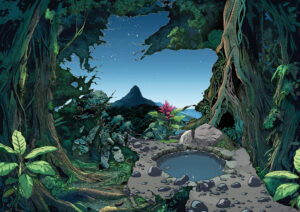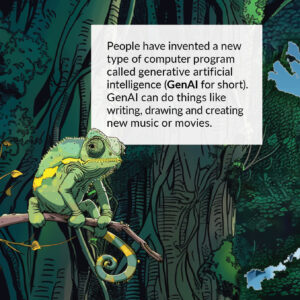Exploring the AI Jungle: Visualising the Landscape of GenAI in Scottish Education
From a designer’s perspective: Elspeth Maxwell, from Dog and Fox Design , is a long-standing creative collaborator with the project team and has a unique talent for visually communicating complexity and nuance in vibrant and accessible ways.
Imagine a dense jungle brimming with vibrant life, where each creature symbolises a key insight. This is the deliberately unexpected and conceptually rich approach we are taking to visually illustrate the findings of Dr. Laura Meagher’s report mapping the policy landscape of GenAI in Scottish schools.
As part of a fruitful creative collaboration with Professor Judy Robertson and Dr. Laura Meagher, designer and illustrator Elspeth Maxwell is creating a visual map that explores the current and near-future state of generative AI in education. Dr. Meagher’s report gathers insights from a variety of policymakers across multiple organizations, each offering their unique perspectives on how GenAI will be used in schools—now and in the near future. The goal of this project is to provide a compelling visual interpretation of these findings, making them accessible and relatable to teachers, policymakers, and students.



WORK IN PROGRESS: details of the visual ‘map’, adding jungle creatures as visual metaphors
Into the GenAI Jungle
“I had recently collaborated with Prof. Robertson and the Data Education in Schools team on Teach Data Literacy: A Guide for Primary Teachers. As graphic designer and illustrator on the project, I had creative freedom to push the artistic envelope to get educators excited about resources for learning and teaching data literacy,” Elspeth explains. “So when the opportunity arose to apply this collaborative creative approach to BRAID WP1, I was all in! It’s a unique chance to take the report’s findings and present them in a visually accessible and appealing way.”
Inspiration for the project stems from a desire to present the information uncovered in the report in an unexpected and engaging way. “We didn’t want to use the ‘predictable’ tech-heavy imagery of glowing cyborgs and holograms. Instead, we were drawn to the idea of a jungle, a metaphor several report participants had used in their responses. This allows us to explore and expound upon each idea creatively, with imagination and humour.”
Picturing the Future of GenAI in Education
“At this time there is no clear ‘landscape’ in which overarching policies have been developed or implemented regarding use of GenAI in Scottish schools, nor is there any neat interdigitation of local or organisational level preliminary policies,” explains Dr. Meagher. “When asked for metaphors to help envision the landscape, interviewees often offered various forms of active exploration through messy, complex contexts.”
Transforming these complex and nuanced responses into visual art is no small feat, so our team has focused on the concept of ‘active exploration’. Prof. Robertson distilled the information from Dr. Meagher’s report into a series of ten key takeaways and a conclusion, using clear and accessible language. From there, we’ve taken the visual metaphor of the jungle and run with it.
“I was intrigued by the idea of using GenAI as part of this collaborative project, and fittingly—given the issues explored in the report—there were both benefits and challenges,” Elspeth notes. “Early on, I had a conversation with ChatGPT-4 to brainstorm visual metaphors based on Prof. Robertson’s outline. This approach turned out to be a double-edged sword.” By way of example, Elspeth explains: “Prof. Robertson suggested including a parrot in the visual, because the term ‘stochastic parrot’ is used as a metaphor to describe the theory that large language models, though able to generate plausible language, do not understand the meaning of the language they process. When prompted, ChatGPT-4 seemingly ‘agreed’ that this was an apt metaphor and referred to itself as a ‘stochastic parrot’. Other prompts resulted in wild inaccuracies—such as suggesting that an octopus is a jungle animal.”
Collaboration and Exploration
The visual metaphor of the AI Jungle has much creative potential, and discussing its implications significantly influenced the design process. “Dr. Robertson’s guidance and Dr. Meagher’s knowledge and expertise ensures that the design interpretation remains true to the data and findings,” Elspeth recalls. “Not to mention that Dr. Meagher’s background in Zoology helps keep us on the right track! Our goal in using this visual metaphor for the project is to inspire people to reexamine their existing opinions and further explore their own ideas about GenAI in education.”

Concept image for a picture book cover.
Visual Impact and Project Goals
The visual map aims to have an impact not only in classrooms on teachers and students, but also on policymakers. “This visual representation has been designed to spark conversations about GenAI in education,” Elspeth explains. “Our hope is that in whatever field of education you are in, there is something here that will inspire new ways of thinking about GenAI and its implications for the future.”
Visual art has a unique ability to make complex information more digestible. “By presenting the data visually, we hope to engage people on a human level,” Elspeth says. “We envision the finished map on classroom walls, surprising and intriguing students and teachers alike.”
Navigating the GenAI Jungle, Together
By combining the insights of the report with visual creativity, this project exemplifies the power of interdisciplinary collaboration to illuminate complex topics in a way that aims to be both informative and inspiring. The concept we developed has sparked potential ideas for more teaching materials, workshops and even a picture book.
“The collaborative nature of this project has led to outcomes none of us could have arrived at alone,” says Elspeth. “Throughout the development of the visuals based on the report’s findings, and the exploration of the present and near-future impact of GenAI on education, it’s been clear that what’s most important is human connection and collaboration.”
– –
Summary
In a creative collaboration, Prof. Judy Robertson, Dr. Laura Meagher, and designer/illustrator Elspeth Maxwell are creating a visual map to illustrate the current and near-future state of generative AI (GenAI) in Scottish schools. This project will transform data and insights from a detailed report into an accessible and engaging visual representation. Part of the initiative, BRAID: Towards embedding responsible AI in the school system: co-creation with young people, the map aims to make the report’s findings more relatable and thought-provoking for educators, policymakers, and the public, fostering a more human understanding of GenAI’s role in Scottish education.
1. Teach Data Literacy: A Guide for Primary Teachers https://dataschools.education/teachdata/
2. BRAID is a UK-wide programme dedicated to integrating Arts and Humanities research more fully into the Responsible AI ecosystem, as well as bridging the divides between academic, industry, policy and regulatory work on responsible AI https://braiduk.org/
3. Mapping the AI Landscape in Scottish Schools
4. On the Dangers of Stochastic Parrots: Can Language Models Be Too Big? 🦜
https://dl.acm.org/doi/10.1145/3442188.3445922

